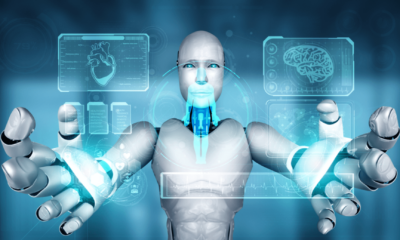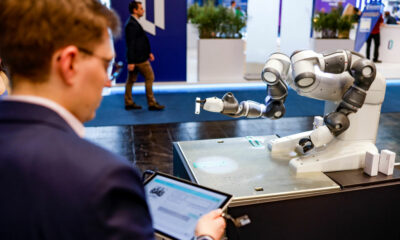TECHNOLOGY
Your Smart Device Will Feel Your Pain & Fear

What if your smart device could empathize with you?
The evolving field known as affective computing is likely to make it happen soon. Scientists and engineers are developing systems and devices that can recognize, interpret, process, and simulate human affects or emotions. It is an interdisciplinary field spanning computer science, psychology, and cognitive science. While its origins can be traced to longstanding philosophical inquiries into emotion, a 1995 paper on #affective computing by Rosalind Picard catalyzed modern progress.
The more smart devices we have in our lives, the more we are going to want them to behave politely and be socially smart. We don’t want them to bother us with unimportant information or overload us with too much information. That kind of common-sense reasoning requires an understanding of our emotional state. We’re starting to see such systems perform specific, predefined functions, like changing in real time how you are presented with the questions in a quiz, or recommending a set of videos in an educational program to fit the changing mood of students.
How can we make a device that responds appropriately to your emotional state? Researchers are using sensors, microphones, and cameras combined with software logic. A device with the ability to detect and appropriately respond to a user’s emotions and other stimuli could gather cues from a variety of sources. Facial expressions, posture, gestures, speech, the force or rhythm of key strokes, and the temperature changes of a hand on a mouse can all potentially signify emotional changes that can be detected and interpreted by a computer. A built-in camera, for example, may capture images of a user. Speech, gesture, and facial recognition technologies are being explored for affective computing applications.
Just looking at speech alone, a computer can observe innumerable variables that may indicate emotional reaction and variation. Among these are a person’s rate of speaking, accent, pitch, pitch range, final lowering, stress frequency, breathlessness, brilliance, loudness, and discontinuities in the pattern of pauses or pitch.
Gestures can also be used to detect emotional states, especially when used in conjunction with speech and face recognition. Such gestures might include simple reflexive responses, like lifting your shoulders when you don’t know the answer to a question. Or they could be complex and meaningful, as when communicating with sign language.
A third approach is the monitoring of physiological signs. These might include pulse and heart rate or minute contractions of facial muscles. Pulses in blood volume can be monitored, as can what’s known as galvanic skin response. This area of research is still in relative new but it is gaining momentum and we are starting to see real products that implement the techniques.
Recognizing emotional information requires the extraction of meaningful patterns from the gathered data. Some researchers are using machine learning techniques to detect such patterns.
Detecting emotion in people is one thing. But work is also going into computers that themselves show what appear to be emotions. Already in use are systems that simulate emotions in automated telephone and online conversation agents to facilitate interactivity between human and machine.
There are many applications for affective computing. One is in education. Such systems can help address one of the major drawbacks of online learning versus in-classroom learning: the difficulty faced by teachers in adapting pedagogical situations to the emotional state of students in the classroom. In e-learning applications, affective computing can adjust the presentation style of a computerized tutor when a learner is bored, interested, frustrated, or pleased. Psychological health services also benefit from affective computing applications that can determine a client’s emotional state.
Robotic systems capable of processing affective information can offer more functionality alongside human workers in uncertain or complex environments. Companion devices, such as digital pets, can use affective computing abilities to enhance realism and display a higher degree of autonomy.
Other potential applications can be found in social monitoring. For example, a car might monitor the emotion of all occupants and invoke additional safety measures, potentially alerting other vehicles if it detects the driver to be angry. Affective computing has potential applications in human-computer interaction, such as affective “mirrors” that allow the user to see how he or she performs. One example might be warning signals that tell a driver if they are sleepy or going too fast or too slow. A system might even call relatives if the driver is sick or drunk (though one can imagine mixed reactions on the part of the driver to such developments). Emotion-monitoring agents might issue a warning before one sends an angry email, or a music player could select tracks based on your mood. Companies may even be able to use affective computing to infer whether their products will be well-received by the market by detecting facial or speech changes in potential customers when they read an ad or first use the product. Affective computing is also starting to be applied to the development of communicative technologies for use by people with autism.
Many universities did extensive work on affective computing resulting in projects including something called the galvactivator which was a good starting point. It’s a glove-like wearable device that senses a wearer’s skin conductivity and maps values to a bright LED display. Increases in skin conductivity across the palm tend to indicate physiological arousal, so the display glows brightly. This may have many potentially useful purposes, including self-feedback for stress management, facilitation of conversation between two people, or visualising aspects of attention while learning. Along with the revolution in wearable computing technology, affective computing is poised to become more widely accepted, and there will be endless applications for affective computing in many aspects of life.
One of the future applications will be the use of affective computing in #Metaverse applications, which will humanise the avatar and add emotion as 5th dimension opening limitless possibilities, but all these advancements in applications of affective computing racing to make the machines more human will come with challenges namely SSP (Security, Safety, Privacy) the three pillars of online user, we need to make sure all the three pillars of online user are protected and well defined , it’s easier said than done but clear guidelines of what , where, who, who will use the data will make acceptance of hardware and software of affective computing faster without replacing physical pain with mental pain of fear of privacy and security and safety of our data.
Source link
TECHNOLOGY
Next-gen chips, Amazon Q, and speedy S3

AWS re:Invent, which has been taking place from November 27 and runs to December 1, has had its usual plethora of announcements: a total of 21 at time of print.
Perhaps not surprisingly, given the huge potential impact of generative AI – ChatGPT officially turns one year old today – a lot of focus has been on the AI side for AWS’ announcements, including a major partnership inked with NVIDIA across infrastructure, software, and services.
Yet there has been plenty more announced at the Las Vegas jamboree besides. Here, CloudTech rounds up the best of the rest:
Next-generation chips
This was the other major AI-focused announcement at re:Invent: the launch of two new chips, AWS Graviton4 and AWS Trainium2, for training and running AI and machine learning (ML) models, among other customer workloads. Graviton4 shapes up against its predecessor with 30% better compute performance, 50% more cores and 75% more memory bandwidth, while Trainium2 delivers up to four times faster training than before and will be able to be deployed in EC2 UltraClusters of up to 100,000 chips.
The EC2 UltraClusters are designed to ‘deliver the highest performance, most energy efficient AI model training infrastructure in the cloud’, as AWS puts it. With it, customers will be able to train large language models in ‘a fraction of the time’, as well as double energy efficiency.
As ever, AWS offers customers who are already utilising these tools. Databricks, Epic and SAP are among the companies cited as using the new AWS-designed chips.
Zero-ETL integrations
AWS announced new Amazon Aurora PostgreSQL, Amazon DynamoDB, and Amazon Relational Database Services (Amazon RDS) for MySQL integrations with Amazon Redshift, AWS’ cloud data warehouse. The zero-ETL integrations – eliminating the need to build ETL (extract, transform, load) data pipelines – make it easier to connect and analyse transactional data across various relational and non-relational databases in Amazon Redshift.
A simple example of how zero-ETL functions can be seen is in a hypothetical company which stores transactional data – time of transaction, items bought, where the transaction occurred – in a relational database, but use another analytics tool to analyse data in a non-relational database. To connect it all up, companies would previously have to construct ETL data pipelines which are a time and money sink.
The latest integrations “build on AWS’s zero-ETL foundation… so customers can quickly and easily connect all of their data, no matter where it lives,” the company said.
Amazon S3 Express One Zone
AWS announced the general availability of Amazon S3 Express One Zone, a new storage class purpose-built for customers’ most frequently-accessed data. Data access speed is up to 10 times faster and request costs up to 50% lower than standard S3. Companies can also opt to collocate their Amazon S3 Express One Zone data in the same availability zone as their compute resources.
Companies and partners who are using Amazon S3 Express One Zone include ChaosSearch, Cloudera, and Pinterest.
Amazon Q
A new product, and an interesting pivot, again with generative AI at its core. Amazon Q was announced as a ‘new type of generative AI-powered assistant’ which can be tailored to a customer’s business. “Customers can get fast, relevant answers to pressing questions, generate content, and take actions – all informed by a customer’s information repositories, code, and enterprise systems,” AWS added. The service also can assist companies building on AWS, as well as companies using AWS applications for business intelligence, contact centres, and supply chain management.
Customers cited as early adopters include Accenture, BMW and Wunderkind.
Want to learn more about cybersecurity and the cloud from industry leaders? Check out Cyber Security & Cloud Expo taking place in Amsterdam, California, and London. Explore other upcoming enterprise technology events and webinars powered by TechForge here.
TECHNOLOGY
HCLTech and Cisco create collaborative hybrid workplaces

Digital comms specialist Cisco and global tech firm HCLTech have teamed up to launch Meeting-Rooms-as-a-Service (MRaaS).
Available on a subscription model, this solution modernises legacy meeting rooms and enables users to join meetings from any meeting solution provider using Webex devices.
The MRaaS solution helps enterprises simplify the design, implementation and maintenance of integrated meeting rooms, enabling seamless collaboration for their globally distributed hybrid workforces.
Rakshit Ghura, senior VP and Global head of digital workplace services, HCLTech, said: “MRaaS combines our consulting and managed services expertise with Cisco’s proficiency in Webex devices to change the way employees conceptualise, organise and interact in a collaborative environment for a modern hybrid work model.
“The common vision of our partnership is to elevate the collaboration experience at work and drive productivity through modern meeting rooms.”
Alexandra Zagury, VP of partner managed and as-a-Service Sales at Cisco, said: “Our partnership with HCLTech helps our clients transform their offices through cost-effective managed services that support the ongoing evolution of workspaces.
“As we reimagine the modern office, we are making it easier to support collaboration and productivity among workers, whether they are in the office or elsewhere.”
Cisco’s Webex collaboration devices harness the power of artificial intelligence to offer intuitive, seamless collaboration experiences, enabling meeting rooms with smart features such as meeting zones, intelligent people framing, optimised attendee audio and background noise removal, among others.
Want to learn more about cybersecurity and the cloud from industry leaders? Check out Cyber Security & Cloud Expo taking place in Amsterdam, California, and London. Explore other upcoming enterprise technology events and webinars powered by TechForge here.
TECHNOLOGY
Canonical releases low-touch private cloud MicroCloud

Canonical has announced the general availability of MicroCloud, a low-touch, open source cloud solution. MicroCloud is part of Canonical’s growing cloud infrastructure portfolio.
It is purpose-built for scalable clusters and edge deployments for all types of enterprises. It is designed with simplicity, security and automation in mind, minimising the time and effort to both deploy and maintain it. Conveniently, enterprise support for MicroCloud is offered as part of Canonical’s Ubuntu Pro subscription, with several support tiers available, and priced per node.
MicroClouds are optimised for repeatable and reliable remote deployments. A single command initiates the orchestration and clustering of various components with minimal involvement by the user, resulting in a fully functional cloud within minutes. This simplified deployment process significantly reduces the barrier to entry, putting a production-grade cloud at everyone’s fingertips.
Juan Manuel Ventura, head of architectures & technologies at Spindox, said: “Cloud computing is not only about technology, it’s the beating heart of any modern industrial transformation, driving agility and innovation. Our mission is to provide our customers with the most effective ways to innovate and bring value; having a complexity-free cloud infrastructure is one important piece of that puzzle. With MicroCloud, the focus shifts away from struggling with cloud operations to solving real business challenges” says
In addition to seamless deployment, MicroCloud prioritises security and ease of maintenance. All MicroCloud components are built with strict confinement for increased security, with over-the-air transactional updates that preserve data and roll back on errors automatically. Upgrades to newer versions are handled automatically and without downtime, with the mechanisms to hold or schedule them as needed.
With this approach, MicroCloud caters to both on-premise clouds but also edge deployments at remote locations, allowing organisations to use the same infrastructure primitives and services wherever they are needed. It is suitable for business-in-branch office locations or industrial use inside a factory, as well as distributed locations where the focus is on replicability and unattended operations.
Cedric Gegout, VP of product at Canonical, said: “As data becomes more distributed, the infrastructure has to follow. Cloud computing is now distributed, spanning across data centres, far and near edge computing appliances. MicroCloud is our answer to that.
“By packaging known infrastructure primitives in a portable and unattended way, we are delivering a simpler, more prescriptive cloud experience that makes zero-ops a reality for many Industries.“
MicroCloud’s lightweight architecture makes it usable on both commodity and high-end hardware, with several ways to further reduce its footprint depending on your workload needs. In addition to the standard Ubuntu Server or Desktop, MicroClouds can be run on Ubuntu Core – a lightweight OS optimised for the edge. With Ubuntu Core, MicroClouds are a perfect solution for far-edge locations with limited computing capabilities. Users can choose to run their workloads using Kubernetes or via system containers. System containers based on LXD behave similarly to traditional VMs but consume fewer resources while providing bare-metal performance.
Coupled with Canonical’s Ubuntu Pro + Support subscription, MicroCloud users can benefit from an enterprise-grade open source cloud solution that is fully supported and with better economics. An Ubuntu Pro subscription offers security maintenance for the broadest collection of open-source software available from a single vendor today. It covers over 30k packages with a consistent security maintenance commitment, and additional features such as kernel livepatch, systems management at scale, certified compliance and hardening profiles enabling easy adoption for enterprises. With per-node pricing and no hidden fees, customers can rest assured that their environment is secure and supported without the expensive price tag typically associated with cloud solutions.
Want to learn more about cybersecurity and the cloud from industry leaders? Check out Cyber Security & Cloud Expo taking place in Amsterdam, California, and London. Explore other upcoming enterprise technology events and webinars powered by TechForge here.
-

 PPC5 days ago
PPC5 days ago19 Best SEO Tools in 2024 (For Every Use Case)
-
SEARCHENGINES7 days ago
Daily Search Forum Recap: April 16, 2024
-

 SEO7 days ago
SEO7 days agoGoogle Clarifies Vacation Rental Structured Data
-

 MARKETING6 days ago
MARKETING6 days agoStreamlining Processes for Increased Efficiency and Results
-
SEARCHENGINES6 days ago
Daily Search Forum Recap: April 17, 2024
-

 SEO6 days ago
SEO6 days agoAn In-Depth Guide And Best Practices For Mobile SEO
-

 PPC6 days ago
PPC6 days ago97 Marvelous May Content Ideas for Blog Posts, Videos, & More
-

 MARKETING5 days ago
MARKETING5 days agoEcommerce evolution: Blurring the lines between B2B and B2C















You must be logged in to post a comment Login